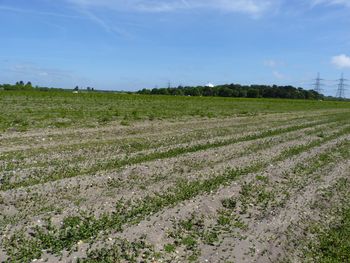Site Data from an Evaluation at Sizewell Gap, Part 1 of Galloper Offshore Wind Farm Onshore Archaeological Works 2011-2013
Wessex Archaeology, 2022. https://doi.org/10.5284/1093227. How to cite using this DOI
Data copyright © Wessex Archaeology unless otherwise stated
This work is licensed under a Creative Commons Attribution 4.0 International License.
Primary contact
Wessex Archaeology
Portway House
Old Sarum Park
Salisbury
SP4 6EB
UK
Tel: 01722 326867
Fax: 01722 337562
Resource identifiers
- ADS Collection: 4543
- DOI:https://doi.org/10.5284/1093227
- How to cite using this DOI
Introduction

This collection comprises site data (reports, images, a survey drawing, spreadsheets and scanned site records) from the first phase of archaeological work associated with the development of a new onshore substation and related infrastructure for Galloper Offshore Wind Farm.
Wessex Archaeology was commissioned by Galloper Wind Farm Ltd to carry out a pre-determination archaeological field evaluation in advance of the submission of a development consent order to build an offshore wind farm and associated development, including a new substation and associated infrastructure on land at Sizewell Gap, Leiston, Suffolk. Part 1 of the LCS161 Galloper archive relates to fieldwork undertaken between June 2010 and June 2013 under project numbers 77610 and 77611.
In this phase of works a total of 35 machine excavated trial trenches, each measuring 25m x 1.8m, were excavated. The evaluation proved the existence of features consistent with small scale Late Prehistoric and Romano-British activity probably relating to farming practices. The pottery recovered from the site, although mainly confined in any quantity to ditch 1203 in TR 12 is of Romano-British date. Finds were conspicuously absent from the remainder of the features across the site although a sherd of Saxon pottery was recovered from topsoil. Some struck flint of prehistoric date was also recovered as was a moderate quantity of burnt flint from pit 3003 again consistent with prehistoric activity. The site occupies a raised area distinct from the surrounding low lying ground suggesting this may have remained relatively dry in periods of wet weather or possible tidal inundation and therefore would have been suitable for occupation. The ditches observed on the site did show episodes of re-cutting, and the sandy nature of the natural ground and exposed nature of the site would have meant re-establishing drainage/boundary features on a regular, albeit seasonal basis. Interestingly very few of the ditches could be identified traversing several of the evaluation trenches.
Fieldwork excavation and further mitigation undertaken from 2014 to 2016, under projects 104810-104812 are deposited separately in part 2.





